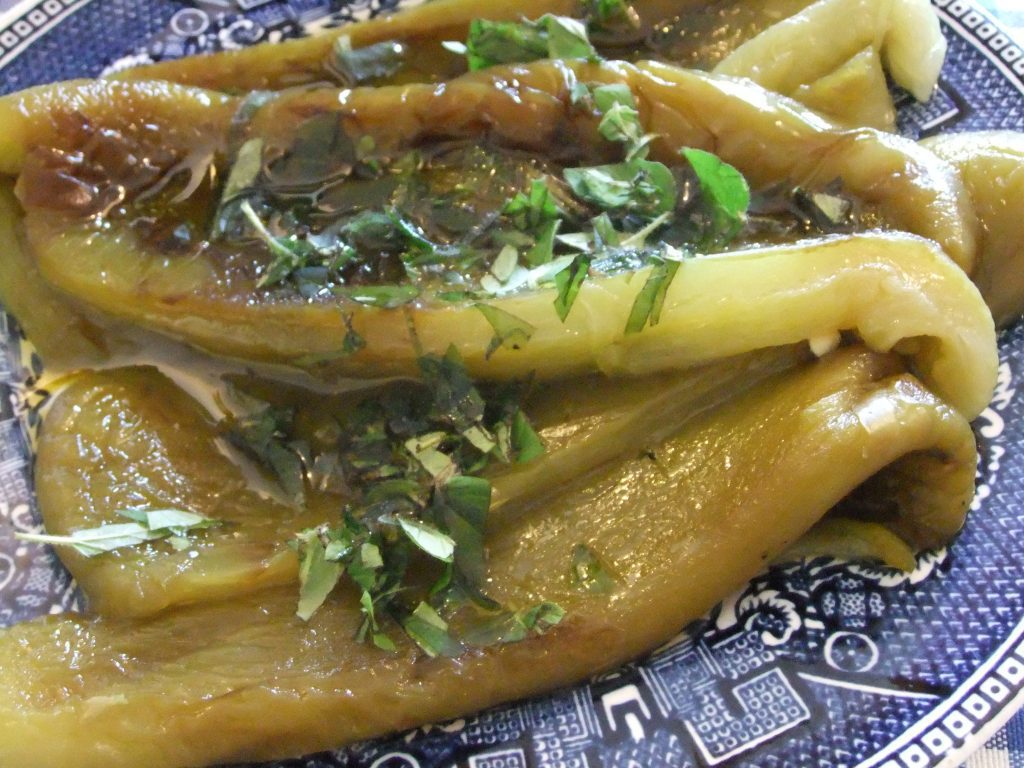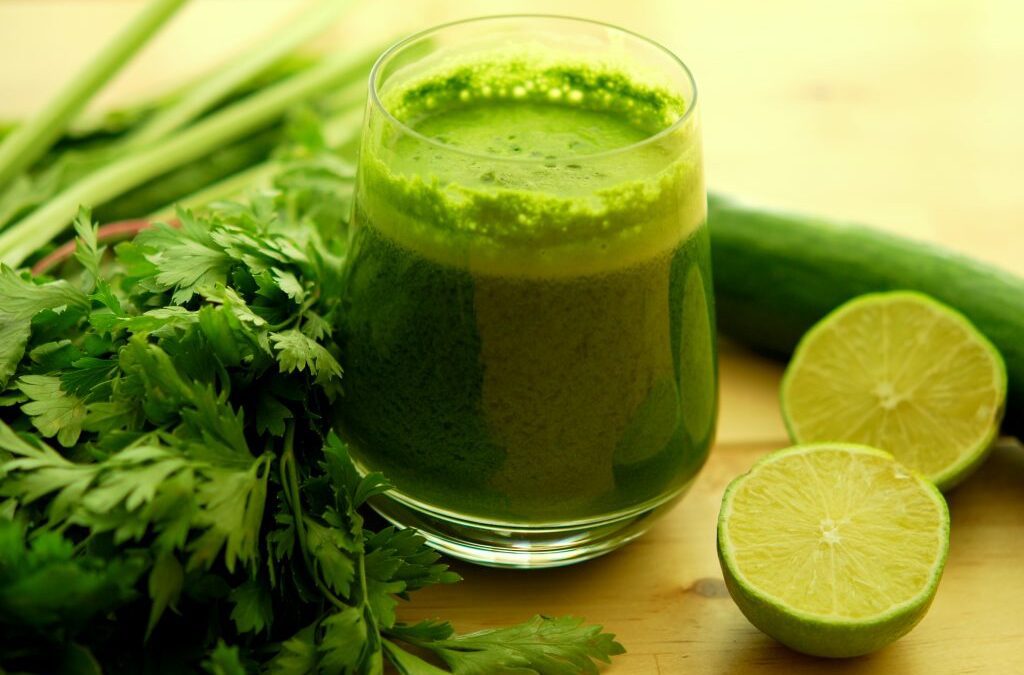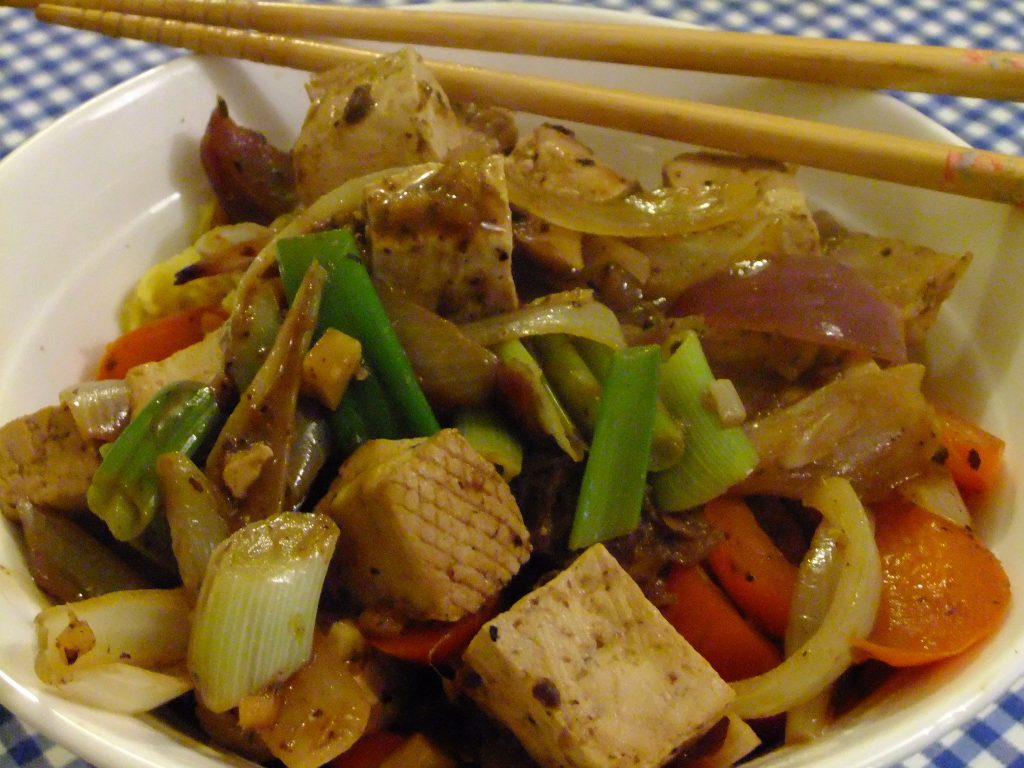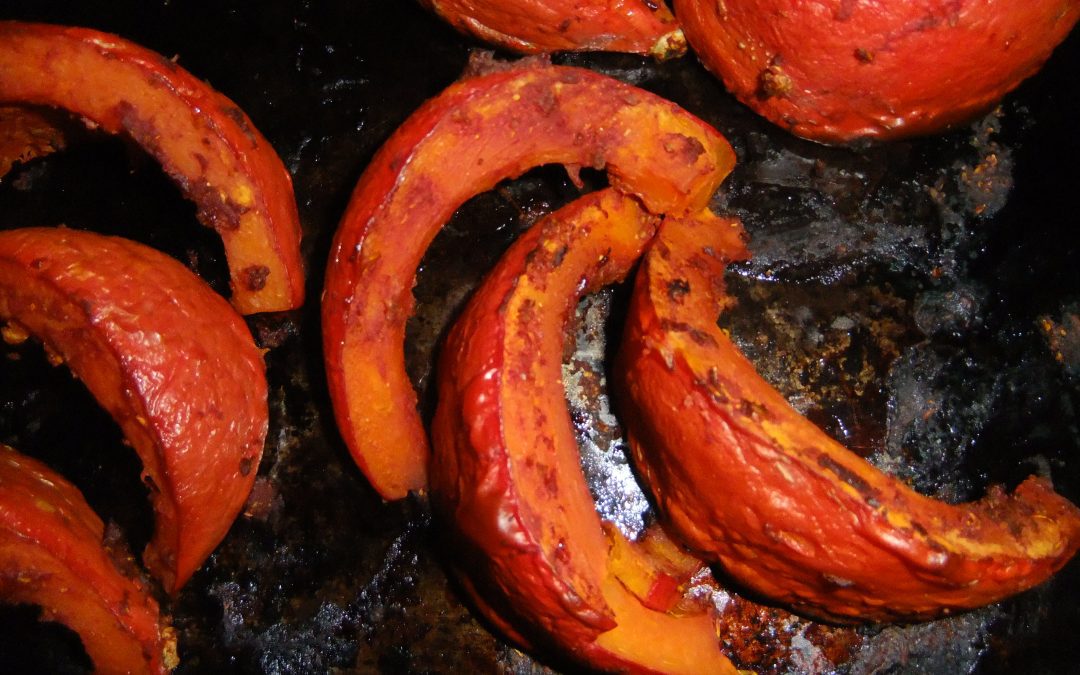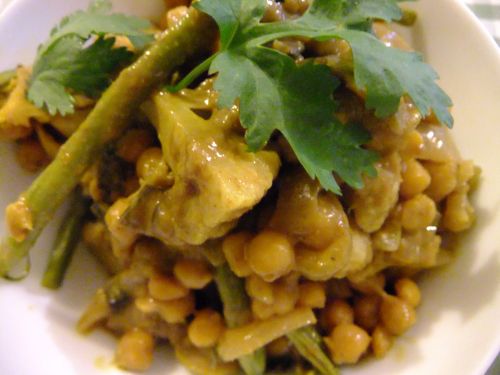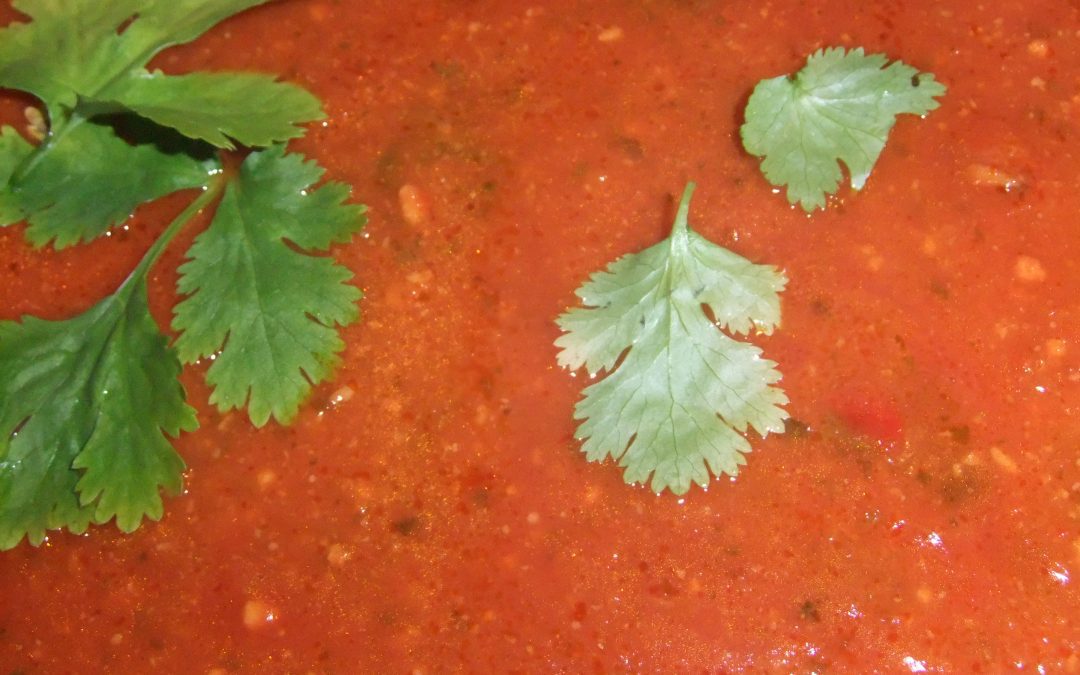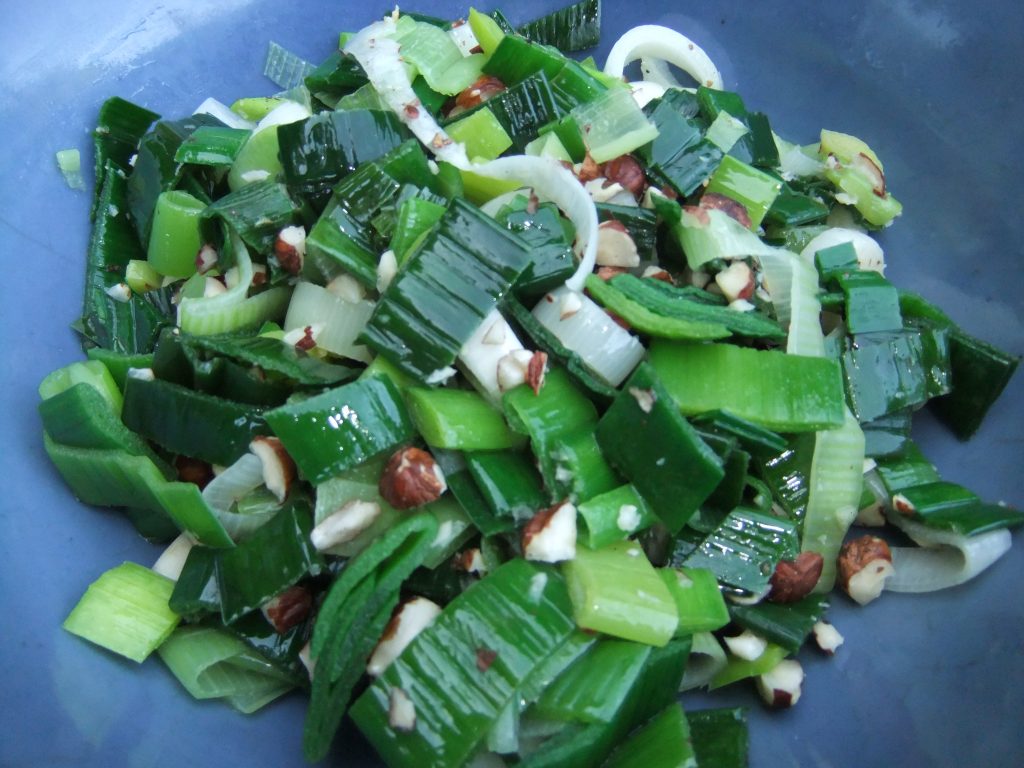
Jun 4, 2014 | Anna's Best Recipes, Sides, starters, soups & snacks
This is a superb but simple recipe I cut out of a magazine years ago. No idea who wrote it. I made a large plate of it recently for a family birthday and we grazed on it for the rest of the weekend. The aubergines cook quite quickly, especially with sliced and grilled or fried. Cook right through: aubergines don’t taste good if undercooked so make sure they are translucent, with no trace of white. If you can’t get pine nuts, you could use flaked almonds instead.
For 4-6 people as a starter, or grazing platter
2-3 medium, aubergines, about 700g
2 tbs sea salt (flakes or finely ground, it doesn’t matter)
About 125ml extra virgin olive oil
50g pine nuts
Small bunch fresh mint, half chopped, half in sprigs
Small bunch fresh flat leaf parsley, half chopped, half in sprigs
Few drops balsamic vinegar
Freshly ground black pepper
- Cut the aubergines lengthways into 1cm slices. Score both sides of each with a fork. Sprinkle with salt. Drain on a rack for 10-20 minutes, then pat dry with kitchen paper. The salting of the aubergine draws out the bitter juices and makes the end product much sweeter.
- Meanwhile, heat a ridged stove-top grill pan until very hot. Wipe with olive oil, using a wad of crumpled kitchen paper or heatproof brush. Paint each slice with oil. Arrange on hot pan, pressing down firmly. cook for 3-5 minutes on each side until grill-marked, tender and aromatic.
- Heat a separate frying pan, add pine nuts and toast gently until golden. Set aside.
- Scatter cooked aubergine with chopped mint, parsley, black pepper and balsamic vinegar. Loop slices on serving plates, add pine nuts and sprigs of mint and parsley and serve.Why this is good for you:
Raw herbs like parsley and mint are a powerhouse of antioxidant, anti-ageing nutrients that help soothe your digestive system. Mint is anti-spasmodic and so can reduce wind. Parsley is rich in iron and is great for your kidneys too. Aubergines are rich in fibre, which is good news for the beneficial bacteria in your gut – they use the indigestible fibre in your food to make healing substances to repair and maintain the health of your small and large intestine. People who eat more vegetables have a lower incidence of ALL digestive disorders, including gallstones, colitis and gastritis. Like most vegetables, aubergines are also high in potassium which helps your body respond well to your natural thyroid hormone (T3). This results in more energy, thicker hair and better bowel regularity.

May 21, 2014 | Anna's Best Recipes, Sides, starters, soups & snacks
The good weather got me thinking of this really simple, delicious dish. A Greek classmate once showed me how to make it. She simply charred the peppers in a few minutes over an open gas flame but you can use a grill. This dish works well as a starter with some fresh bread, or as a side dish alongside some meat, grilled/baked white fish or a vegetable frittata. It’s also great for a summer buffet. Using goat or sheep feta gives a lovely crumbly texture and tangy taste and is easier to digest than imitation feta made from cow’s milk.
If you don’t have oregano, you could also use fresh mint or flat leaf parsley.
For 2 people:
2 large green peppers, whole, washed
1 dsp dried oregano or tbsp chopped fresh oregano leaves
1-2 tbs good quality extra virgin olive oil
20g goat/sheep feta cheese
1. Put the green peppers on a baking sheet under a hot and cook (turning frequently) until most of the skin is charred and the peppers are soft and slightly collapsed.
2. Remove from the heat, leave on the baking sheet, and cover with a large bowl or saucepan for 15 minutes or so. This softens the skins and makes them easier to peel.
3. On a plate (to catch the delicious juices) peel and discard the skins of the peppers. Slice into around 4 lengthways. Remove and discard the stalks and anything that’s not green.
4. Lay the peppers with their juices on a fresh plate.
5. Sprinkle over some freshly ground some black pepper and the oregano. Crumble the feta into little pieces and scatter over. Finally, drizzle over the olive oil.
Why this is good for you
Oregano, especially eaten fresh, is a powerhouse of volatile antioxidant rich oils. These oils help keep your skin young and firm, soothe your digestive system, and even help eliminate infections and protect you against life-threatening diseases. Oregano helps combat the yeast overgrowth that contributes to cystitis and sinusitis. Oregano is really easy to grow in Ireland in a pot (in a flowerbed it takes over!). If you use it often, it keeps sprouting new, tender leaves all through the summer. Green peppers, like all green veg, are rich in magnesium needed for stress management, great skin and being “regular”. Feta made from goat/sheep milk is lower in allergenic proteins than cows milk. For that reason, some people who cant take cows milk products find they can tolerate moderate amounts of goat/sheep milk products. Goat’s milk is closest in chemical composition to human milk.

May 14, 2014 | Anna's Best Recipes, Sides, starters, soups & snacks
This is a very quick and easy uncooked vegetable dish which I really like. With some protein like fish, meat, a frittata/omelette or a bean salad it provides a balanced meal. Unless you have tons of energy to pound away for ages with your hands, make this recipe using smallish sprigs of young kale (April-June) – it’s much easier to work. As you might have noticed I’ve got a bit of a green theme going on this month. The power of vegetables to lift your wellbeing is big in food research right now (see my May 2014 newsletter). In my opinion, eating lots of green stuff is one of the most useful things you can do to help your body and your mind.
For 2-3 people:
1 bag tender young organic kale
1-2 tablespoons extra virgin olive oil
½-1 ripe avocado
Cayenne pepper to taste
1 1/2 tbs sunflower seeds (or pumpkin seeds, chopped Brazil nuts or hazelnuts)
Lemon or lime juice to taste
1/2 tsp paprika, or to taste
1 tbs finely sliced or chopped spring onions or red onion (if you can eat cooked onions but not raw ones, try soaking the sliced/chopped onion in the lemon or lime juice for 15 minutes – it totally takes the heat out!)
- Remove any stalks from the washed kale and place in a large bowl.
- Kneed, pound and squish the kale with your hands for around 5 minutes until it is wilted (you might like to use rubber gloves for this as the juice can stain your nails).
- Add the avocado and mix it into the mixture, mashing as you do so.
- Add all the other ingredients and serve.
Serve with:
Baked or grilled, roast or poached fish or chicken, a frittata or omelette or a beany salad
Why this is good for you:
Kale is high in folic acid which helps your body carry out the daily repair and maintenance on your stomach and intestines. Kale, like all dark green veg, is rich in magnesium which is needed to relax your mind and get a good nights sleep. Magnesium also helps keep your skin in good condition by supporting your liver to clear toxins out of the body. Things like psoriasis or acne are usually a sign of poor liver function. Avocados and raw olive oil are rich in vitamin E which moisturises your skin (and everything else) from within. the reason I suggest using organic kale is that like baby spinach, “conventional” kale is in the top 3 most agri-chemical contaminated fresh produce.

May 8, 2014 | Anna's Best Recipes, Desserts & drinks
This is my absolute favourite juice of the moment. You need a masticating juicer like the Samson from www.juicers.ie for juicing leafy greens. If you can get organic produce (especially spinach) so much the better. Non-organic spinach is one of top 3 most agri-chemical contaminated produce so its best avoided unless organic.
For 1 approximately 250ml serving
1/2 cucumber, including skin
3cm peeled ginger root
2 celery sticks
3 kale leaves (optional)
Large handful baby spinach or green cabbage leaves (cabbage is great for healing your gut)
Juice 1/2 lime or 1 dsp fresh lemon juice
Optional (for sweetness): 1 small apple, skin and all
Optional (for sweetness): A few drops of stevia to taste (see my “larder & shopping” section on this blog) to sweeten
Why this recipe is good for you:
Because its contains ginger, lemon/lime and lots of magnesium-rich chlorophyll (greens) this will turbo charge your liver and aid detoxification. The natural enzymes in the raw, fresh juice aid digestion and help reduce inflammation in your digestive system, joints and more. Green vegetable based juices are much more beneficial than fruit juices because they are lower in sugars. Massive amounts of sugars (even from natural sources like fruit) slow liver function and aren’t conducive to 100% health. Refined sugars are more problematic still. Did you know that your thymus glads production of T-cells to fight infection is significantly lowered every time you eat sugar. A peer-reviewed study showed this. No wonder so many people get sick after Christmas, Easter and other sugury feasts that go on for days!

Jan 29, 2014 | Anna's Best Recipes, Main courses
I love this cheap, aromatic dish for a comforting weeknight dinner. The tofu (or chicken fillet) takes up the flavour of the ginger and the black bean sauce well. It’s a good “crossover” dish which means you can feed meat-eaters and all but the strictest vegetarians together. To feed 1 vegetarian 1 arnivore halve the quantity of tofu and add 1 small chicken fillet (sliced 1cm thick across the grain) at the same time as the tofu. Cook till tender. You can then divide the tofu from the meat when serving (or on your plate, as my husband does when stay pieces of tofu escape onto his plate!!). If you really can’t abide tofu, then just use a small chicken fillet per person and drop the tofu.
For 2
See my larder & shopping section for where to buy new-to-you ingredients
1 rounded teaspoon extra virgin coconut oil
1 large onion (red if possible), peeled, cut in half and sliced into wedges (like the segments of an orange)
2 large cloves garlic, peeled and crushed or chopped roughly
1 dsp fresh root ginger, peeled and finely chopped or grated
4 large red peppers, de-seeded and sliced
250g organic, gmo-free fermented tofu (cut in approximately 1.5cm cubes)
1 tbs black bean sauce from Asian shops or use home-made (see recipe below)
A squeeze of lemon juice
Optional: 1 tbs dry sherry
Freshly ground black pepper
To serve:
2-3 cupfuls of cauliflower rice (home-made or from supermarket freezer section) or 100g brown basmati rice (dry weight)
- If using rice, put it on to cook (see “how to cook brown rice” post for an easy way cook a lovely golden-coloured rice).
- Throw the onions into a frying pan or wok with the coconut oil and the red peppers over a medium heat. Add a tiny splash of boiling water or vegetable stock, put a lid on, and sweat for 5-10 minutes until everything is softened a little.
- Add garlic and ginger, turn up the heat and cook for 1 minute, stirring.
- Add tofu/chicken, black bean sauce and sherry. Simmer, covered, for 5-10 mins, stirring occasionally, until the tofu is cooked through (it will swell a little when it’s cooked), and the chicken (if using) is opaque.
- Add lemon juice and black pepper and stir.
- Serve with the rice
Variation:
Add tamari sauce to taste.
Use quinoa grains instead of brown rice if you want. It boosts the protein content of the meal.
You could also add in odds and ends from the fridge eg. leftover cooked green beans or cabbage or a few spring onions, sliced in 3cm lengths.
Black bean sauce:
This sauce keeps for 6-8 months in the fridge. If you own a mini food-processor it is worth making a jarful as it takes around 5 minutes to make from scratch. The type of black beans you need for this are semi-dried and are black and wrinkly-looking, like currants. They are available in the Asia Market or other oriental stores – you will need to ask for them though as they are usually labelled in Chinese. You CAN buy black bean sauce ready made but its usually packed with vitality-sapping sugar, maltodextrin and (watch out you gluten-sensitives) gluten.
Ingredients:
4 tbs black beans
Sherry (ideally dry but sweet will do)
1. Grind 4 tablespoons black beans to a paste in a pestle and mortar or a miniature food processor.
2. Add enough sherry to mix to a paste the consistency of yoghurt.
3. Store in a glass jar with lid in the fridge for up to 6 months – the sherry preserves everything.
Why this is good for you
This recipe give you a small amount of rice (or even better, use cauliflower “rice”) and a larger amount of protein and low-starch veggies. This helps your health, waistline, and energy levels. Herbs and spices such as ginger and garlic help your liver cleanse the large amount of natural (and unnatural) chemicals we are exposed to every day. Good liver function is needed for almost all aspects of good health. Your liver is important for hormone balance, protecting you against life-threatening illness, maintaining good energy and even skin health. Fermented non-gmo soya products (eg fermented tofu, tempeh, miso) act as selective oestrogen receptor modulators, help balance hormones for both women and men.
Scientific research suggests that unfermented soya products (eg. soya “cheeze”, soya milk) are not helpful to our health. It’s best not to eat unfermeted tofu very much. Like wheat, milk, peanuts and cashews it is very high in lectins which cause temporary damage to your digestive system. If you can, then avoid regular intake of inferior (non-organic, non-fermented) tofu products. They are made using soy isolate (rather than whole soya beans)which can also can be contaminated with aluminium. Genetically modified foods cause immune suppression in animal studies and so are best avoided – good tofu will say non-gmo or organic on the package. You can keep leftover raw tofu for a week or more by covering it in salty water in the fridge.

Nov 27, 2013 | Anna's Best Recipes, Sides, starters, soups & snacks
I love this warming, filling soup that’s rich in protein. A complete meal with a little green salad on the side (or some spinach leaves or leftover cooked greens stirred in at the end) it makes a complete meal. I usually freeze the leftovers in individual serving sizes to take to work on a cold, frosty day.
For 4 (or 2 with generous leftovers)
1 large onion, chopped
2 sticks celery, sliced thinly
2 cloves garlic, chopped roughly
500ml carton of passata (sieved tomatoes) or a 400g can tomatoes chopped or whole
750ml water or leftover vegetable cooking water (e.g. from steaming veg)
175g red lentils
1 teaspoon additive-free vegetable stock powder. Dr Coys Organic Vegetable Bouillon is best and suitable for SC diet. From health stores.
3 heaped tbsp freshly chopped or frozen chopped parsley
Freshly ground black pepper
1-2 tbsp extra virgin olive oil
Optional extras (health and flavour boosters) to add to the :
1 tablespoon finely grated fresh ginger + heaped teaspoon turmeric powder added during cooking
1. Put the onion, celery, garlic, tomatoes and water into a large saucepan. Add the lentils afterwards making sure they are submerged in liquid. Lentils tend to stick to the bottom so I don’t stir this until they are cooked.
2. Boil for 20 mins/until lentils are soft. Only stir the lentils gently at the very top if they are stuck together, otherwise leave them alone.
3. Mix the veg stock powder into a little water and add to the soup AFTER the the lentils are cooked otherwise the salt will make the lentils take forever to cook.
4. If you like a smoothish soup then add the parsley and olive oil and blitz with a stick blender or in a food processor.
Variation:
Add 2 sliced carrots along with the celery and onion.
Health boosting tip:
Soak your lentils overnight in cold water. This starts them sprouting, which makes them even more digestible. I don’t bother unless I have extra time to spare.
Why this soup is good for you:
Lentils are rich in magnesium which is Nature’s tranquiliser, helping reduce stress. They and onions are also rich in soluble fibre, which feeds beneficial bacteria in your gut. “Good” bacteria help produce digestive enzymes to help you digest your food. They also generate butyrate, which aids daily repair of your bowel – good news for your skin, your hair, your digestion, even your mood. Lentils, like all beans and pulses, need to be either sprouted or boiled for at least 10 minutes to make them digestible. However, lentils, split peas and all sprouted or fermented versions (eg bean sprouts, tofu) are the easiest of the beans/pulses to digest because they are lower in protease inhibitors. Protease inhibitors are substances that inhibit digestion and are found to some extent in all plant foods – vegetables, nuts, seeds, beans. Remember that beans, seeds and nuts are designed to be eaten by an animal, pass through the gut undigested, and then be deposited by the animal in a nice blob of “fertiliser” to grow into a new plant! Protease inhibitors are found in the skins of beans and pulses and are neutralised by soaking in cold water for at least 12 hours and then sprouting or fermenting or boiling hard for 10 minutes. Sieved tomatoes (passata) are rich in lycopene and beta carotene – fantastic for eye health and getting heathier looking skin. The extra virgin olive oil helps your body absorb the beta carotene.

Nov 12, 2013 | Anna's Best Recipes, Sides, starters, soups & snacks
This is another lovely recipe from Food, Glorious Food by Patrick Holford. If you are using pumpkin for this recipe, use a small one, rather than the large watery-fleshed ones used for carving Halloween lanterns. We loved these and other people seem to love them too. Great hot, warm or at room temperature as an accompaniment to lots of green vegetables and some form of protein (e.g. beans, pulses, meat, fish).
For a more Mediterranean flavour use oregano/Herbes de Provence and ground sweet paprika instead of cumin, coriander and turmeric.
For 4
950g pumpkin or a large butternut squash, washed but unpeeled
Level tsp turmeric
Rounded tsp ground cumin
Rounded tsp ground coriander
Half level tsp Himalayan salt or sea salt
2 tbs (140g tin) tomato puree
1 tbsp olive oil
- Preheat oven to 200C (180C fan).
- Cut the squash or pumpkin in half length-ways and scrape out the seeds and pulp with a spoon. For the squash, cut each half into 4, length-ways, so you have 8 long pieces. If using pumpkin, aim to cut into lengthways wedges about 3cm thick.
- Mix the turmeric, cumin, coriander, salt, tomato puree and oil together in a bowl, then rub the paste all over the squash or pumpkin until evenly coated.
- Place the squash in a roasting dish and cook for 45-60 minutes or until the flesh is soft when pierced or squashed.
Serving ideas:
Use as an accompaniment to my chickpea and cauliflower curry for a filling meal.
Substitute for baked potatoes as an accompaniment for meat, fish or a salad
Cut the leftovers into bite sized chunks and mix with salad and beans, fish, meat or eggs for a healthy lunch or lunchbox
Why this is good for you:
All orange vegetables are rich in beta carotene, which helps give your skin an attractive golden glow. Most peoples bodies convert beta carotene to vitamin A, needed to protect against infections and for good vision and healthy skin. Herbs and spices are powerful antioxidants, which fight inflammatory conditions like eczema, Crohn’s, colitis and rheumatoid arthritis. Squash or pumpkin is a healthier alternative to potatoes as it contains more nutrients, more fibre and less (natural) sugar.

Nov 8, 2013 | Anna's Best Recipes, Main courses
This recipe comes from Food Glorious Food, by Patrick Holford and Fiona McDonald Joyce. I did adapt the quantities slightly, increasing the chickpeas, giving more protein to keep you fuller for longer. We also used curry powder instead of the curry paste recommended and it was still lovely. It isn’t hot. The curry is really a meal in itself without needing accompaniments though we did roast some pumpkin wedges. We coated them in tomato puree and spices according to Patrick and Fiona’s recipe for Indian Spiced butternut squash, also from the same book. Don’t be tempted to leave out the coconut oil – extra (healthy) oils are very important for keeping you fuller longer when you eat animal-free meals.
For 3 big eaters, with a little left for lunch next day:
Remember to go to my “larder & shopping” section for unusual ingredients.
2 tbsp extra virgin coconut oil
2 heaped tbs Thai curry paste or Sharwoods Madras curry powder (or any curry powder – make sure to check labels for gluten if relevant)
2 large onions, sliced
2/3 large cauliflower, broken into bite size florets
2 x 400g tins chickpeas or 220g dried chickpeas, soaked overnight, then boiled till tender to yield 440g when cooked and drained (about 2 mugs)
400ml can full fat coconut milk
100ml hot vegetable stock (use 1/4 teaspoon Marigold bouillon or 1/2 a Kallo vegetable stock cube to make this up)
1 tbs tamari sauce
250g fine green beans (or you could use runner beans, cut into 2″ lengths)
Optional: Handful of coriander, torn or roughly chopped
- Put the oil, curry powder and onions in a large heavy-bottomed saucepan or Le Creuset type pot on a medium heat, mix around, cover with a lid or plate and sweat until softened and translucent – this usually takes around 10 minutes. Add the cauliflower and chickpeas to the pan and stir to coat them in the other ingredients.
- Pour in the coconut milk, stock and tamari, and stir. Bring to the boil, then cover and simmer over a gentle heat until the cauliflower is nearly done. I found this took about 15 minutes.
- Stir in the green beans, cover and cook for another 5 minutes or so until they’re tender. Scatter with the coriander leaves (if using) before serving.
To serve: You can eat this curry on its own, or serve with brown rice or with the gorgeous Indian spiced butternut squash recipe I will be posting shortly.
Why this recipe is good for you:
Thousands of clinical studies show that a wide range of spices have profoundly anti-inflammatory properties, helping soothe joints, digestive system and delay ageing. Sometimes people complain that Indian takeaways upset them, thinking it is the spices. It is more likely to be the heavy use of low quality refined oils that promote inflammation and play havoc with their stomachs!! The chickpeas in this recipe are a good source of protein and also of soluble fibre, that feeds beneficial bacteria in the gut to help your health. Chickpeas, like all beans and pulses, need to be soaked and boiled thoroughl (or tinned!) to make them digestible. Virgin coconut oil and full fat coconut milk contain important medium chain triglyceride fats that feed your brain. MCTs also used by the body directly to make energy, rather than being stored as fat – good news if you want to be slim and trim. People with ME/chronic fatigue syndrome particularly benefit from coconut oil in their diets. Cauliflower is a sulphurophane vegetable, helping your liver detoxify used-up hormones and other waste products. Substituting beans/pulses for meat/cheese in some of your meals every week is a good way of helping your kidney function and supporting joint and bone health. Fresh coriander binds to heavy metals such as mercury and aluminium in the gut, helping their safe elimination. “Silver” fillings give off toxic mercury while “normal” tea is high in aluminium, a known neurotoxin. Helping your body eliminate these is good news.

Oct 31, 2013 | Anna's Best Recipes, Dressings, rubs, spreads, sauces & more
This sauce makes a brilliant base in which to cook or heat vegetables, white fish, tofu, pre-cooked lamb, or cooked chickpeas. It also freezes well for future fast dinners. I have also posted my “Aromatic ginger, tomato & coconut chicken” recipe where I use this lovely sauce to cook chicken fillet and spinach.
For enough sauce for 2 people
Remember to check out my “larder & shopping” section for unusual ingredients
25g creamed coconut cut up roughly OR ½ cup of thick full-fat tinned coconut milk
3-4cm approx of fresh ginger root (enough to give 1 rounded dsp ginger when finely grated)
500g (500ml) bottle of passata (sieved tomatoes – from all supermarkets)
2 green chillies or ¼ teaspoon chilli powder (optional)
1 large handful fresh coriander if you have it
2 large garlic cloves
Version 1 (made with food processor or liquidiser)
1. Peel the garlic, de-seed the chillies (or if you like more heat leave them in), chop the ginger and coriander roughly and throw the lot into a small food processor. A food processor is preferable to jug liquidiser as if gets the ingredients ground up more quickly.
2. Add enough of the passata to get everything going and blitz until smooth.
3. Pour into a saucepan, add the rest of the passata and the creamed coconut or coconut milk and simmer for five minutes until the creamed coconut is melted and the sauce has slightly darkened. The sauce is now ready for use. Or cool and store in the fridge for a day or two until needed, or in the freezer.
Version 2 (without kitchen gadgets)
1. De-seed and chop the chillies, crush or finely chop the garlic, chop up the creamed coconut and the coriander roughly, finely grate the ginger.
2. Put all of this, with the passata, into a saucepan
3. Simmer for 5 minutes until the coconut is melted and the sauce has darkened a little. The sauce is now ready for use. Or cool and store in the fridge for a day or two until needed, or in the freezer.
Add green vegetables of your choice and cubes of raw chicken or fish, or cooked lamb or beef and simmer till everything is cooked. Here are some ideas to get you started:
- Chicken pieces and baby spinach (see recipe)
- Stir the following into the sauce and bubble, covered, until the veg are cooked but still crunchy, and the meat is heated through:
- 150 cooked, cubed lamb, 1 x 454g tin or mug of cooked, drained chickpeas, and 4 cups broccoli florets
- 1 1/2 x 450g tins or mugs of cooked, drained chickpeas plus 4 cups green beans cut into 4cm lengths
- 4 cups broccoli florets or 5cm lengths of runner beans and 300g bite-size cubes of firm white fish such as monkfish, lemon sole or coley
- If you are not wanting to lose weight, and are not following a ketogenic or paleo diet, you could also enjoy some brown rice on the side.
Why this recipe is good for you:
Processed tomatoes with no additives are a rich source of lycopene, an antioxidant that protects your skin from the damaging effects UV rays – like an edible sunblock! Your body absorbs lycopene better from pureed tomatoes than from whole tomatoes. Ginger, tomatoes, turmeric and chillies all have anti-inflammatory properties that are helpful for a healthy digestive system and good, clear skin. Non organic rice can be heavily contaminated with arsenic but fresh coriander bind to this and other toxic metals in your intestines, helping them be eliminated from your body. Spices like ginger and garlic help boost liver function, also to eliminate both natural and man-made toxins. Yet more reasons why herbs and spices are fantastic for you. Using passata packaged in glass jars or bottles means less exposure to toxic bisphenol A (BPA) , which is present in the plastic linings of cartons and tins. Scientific studies link BPA to hormonal imbalances such as low libido, endometriosis, fibroids, and hormone breast and prostate cancer) as well as osteoporosis. Limiting your exposure is good news.

Aug 13, 2013 | Anna's Best Recipes, Sides, starters, soups & snacks
This is really simple and works hot, warm, or at room temperature, whichever you fancy. I like to eat this with grilled, poached, or baked fish. I invented this a few years ago but forgot about it until this summer’s heatwave. Good quality unrefined (i.e. cold-pressed) nut oil makes this super-delicious but if you can’t get it, extra virgin olive oil is fine – it just won’t have that nutty flavour.
For 2, as an accompaniment
2 large leeks, including the green parts
2 tbsp cold-pressed walnut or hazelnut oil (or extra virgin olive oil if you cant get nut oil)
2 tbs sherry vinegar (or red wine vinegar)
1 tbsp roughly chopped raw hazelnuts
Lots of freshly ground black pepper
A pinch of Himalayan or Atlantic Sea Salt
1. Cut the leeks in half at the point where the white meets the green part. Clean the green parts by separating the layers from each other and running under the tap to remove any grit. Wash the white parts too. Now cut everything into disks somewhere between half and three-quarters cm thick, just so long as they’re all approximately the same.
2. Steam over boiling water or in an electric steamer until wilted, checking frequently. Over boiling water, this will take maybe three minutes. You want the leeks slightly wilted but still bright green. When wilted, drain for a minute or two.
3. Empty the lot into a serving bowl, add the cold-pressed oil, vinegar, hazelnuts, and seasoning. Toss and serve.
Why this recipe is good for you:
Leeks are a rich source of inulin, which helps feed the good gut bacteria that are important for all aspects of our health – skin, immunity, digestion, and more. The green parts of all vegetables are rich in relaxing nutrient magnesium too – for brain, liver, and bowel health. Cold-pressed, raw nut and seed oils are a fantastic source of omega 6 oils, which we need to balance hormones and boost immunity. A typical Western diet today contains a large amount of refined omega 6 oils (all non-raw or non-cold-pressed/extra virgin nut and seed oils are refined). Consuming a lot of omega 6 oils containing -trans fats are linked to premature ageing, life-threatening disease, hormonal imbalance, low energy, and suppressed immunity. Raw-cold pressed nut and seed oils are best kept in an airtight glass bottle in the fridge to stop them from being damaged by oxygen and light and losing their health benefits. Extra virgin olive oil is more stable and can be kept in a dark cupboard. Dressing a salad with vinegar can help boost digestion.


